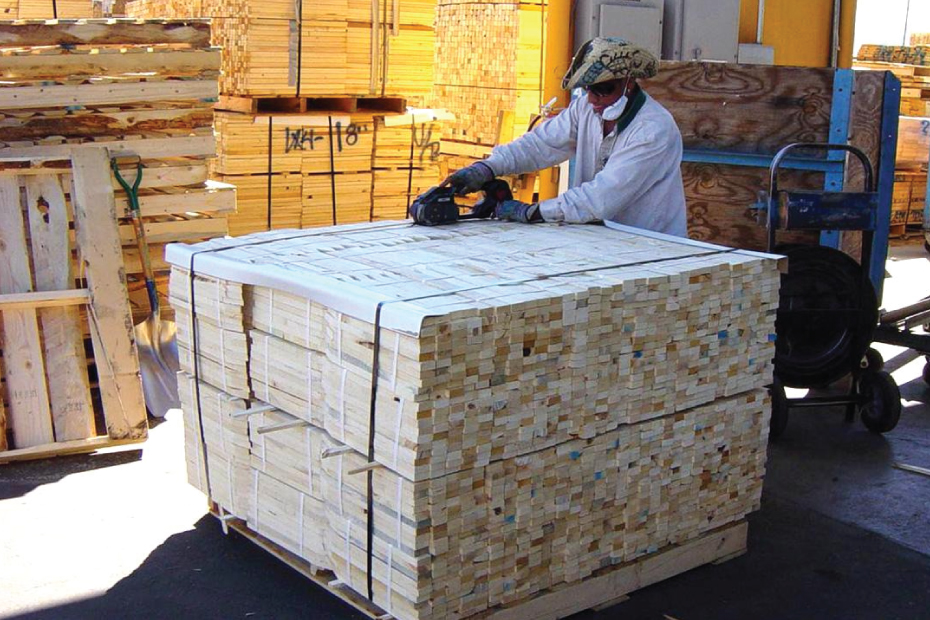
Types of strap
Strap is a flexible flat material, most commonly made from steel or various plastics.
Steel
Steel is the oldest and highest tensile strength strapping. It is available in a variety of widths and thicknesses as well as variations in the grade of steel. Steel is used for heavy duty holding where high strength and minimal stretch are desired. Surface finishes for steel strap include: paint, paint and wax, bluing or zinc and wax. The wax is used to better transmit the tension around the bundle and for use with certain types of tensioners. Common applications include steel coils, bundles of metal, baling wire, bricks and pavers, and roll end-binding.
Polypropylene
Polypropylene strap (oriented or tensilized) is an economical material designed for light to medium duty unitizing, palletizing and bundling. It is available in various widths, thicknesses, and polymer variations (e.g., copolymers). Most polypropylene is embossed, some of which is also printed. This product offers higher elongation at break but tends to have irrecoverable dead stretch with constant stress. What is not generally known to end users is that polypropylene strapping will lose about 50% of the applied tension within one hour, and that this tension loss is accelerated with increases in ambient temperature, consequently although suitable for packs with a degree of stored energy that will take up any relaxtion that occurs in the strap, unacceptable strap slackness may occur after time if used on product that is ‘Solid’ such as bricks or concrete. Further more polypropylene strapping is susceptible to UV degradation and can quickly degrade if left outside exposed to the elements. The sensible choice of colour will retard the process, such as specifying black strap. Similarly, a UV inhibitor can be specified.
Polypropylene strapping may be printed, either during production and pre-embossing for the highest quality and precision, or post production over the embossing for a reduced quality. Both offer security and marketing advantages to the strapped product.
Polyester
Oriented or tensilized polyester and nylon are the strongest plastic strapping products and are used as a viable alternative to steel strapping in some industries. Polyester provides excellent retained tension on rigid loads. Its excellent recovery properties help a load absorb impact without strap breakage.
There are specialized types available for specific applications. For instance, in cold climates a strap bonded in hot melt glue is used because it is weather-proof.
Nylon
Nylon strap has the greatest specific strength of the three plastics, however it is rarely used due to its high price. In the past nylon strap used to be very popular, but over time polyester has replaced almost all of its use. One application that still uses this type of strap is cold room applications, because it does not creep as much as the other types of plastic.
Corded and woven
Corded and woven strapping are available in several constructions, primarily involving polyester and rayon. Some types are reusable. Because this system uses a buckle for a joint, corded and woven strapping can have a larger system strength than steel banding. Corded polyester strapping also has a higher elongation than other strapping systems, which gives it an ideal memory for sea and rail shipments. Because corded and woven polyester straps are light and soft, they are also a safer alternative to steel banding.
Paper
Paper strap is used to strap paper products between industrial processes. This allows the bundle to be introduced into the process without the need to cut the straps, which can lead to the product falling apart prematurely.
Composite
Composite strapping has filaments embedded in it. In the load securing industry it is often referred to as “synthetic steel”. It is very abrasion resistant and has the highest joint efficiency when used with a buckle. Both advantages are not affected by climate.
Uses of strapping
Examples include:
- Bundling items together for handling and shipment: newspapers, pipe, lumber, concrete block, etc.
- Attaching items to pallets, skids, and crates
- Reinforcing wooden boxes, crates, and corrugated boxes, such as gaylords
- Attaching items to flatcars, flatbed semi-trailers,
- Securing a unit load of bricks, packaged glass, metal parts, etc.
- Closing corrugated boxes and shipping containers
- Securing coils of steel or paper
- Holding bales of agricultural products or textiles
- Load securing items within intermodal containers, boxcars, and semi-trailers
Strapping is most often used in complete horizontal or vertical bands. Edge protectors are used to help spread the load at corners and reduce damage to the load by the tensioned strap. Strapping can also be used in loops attached to holding locations on rail cars, skids, etc.